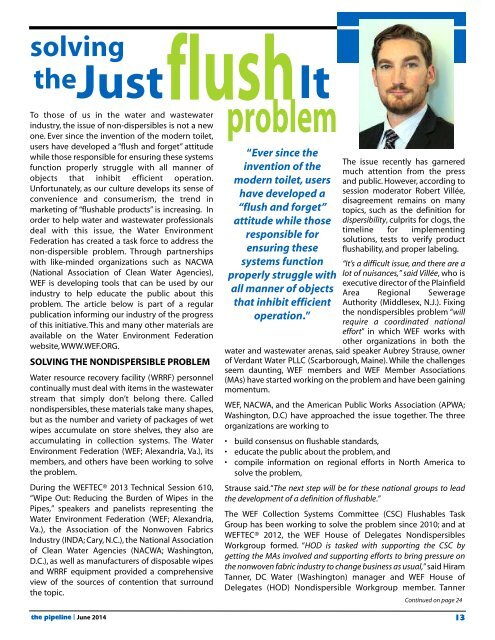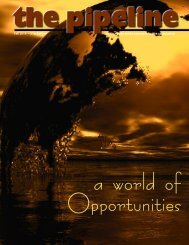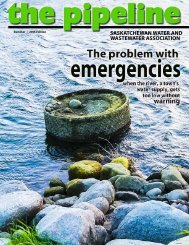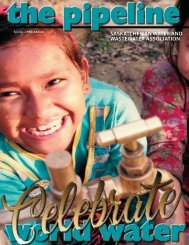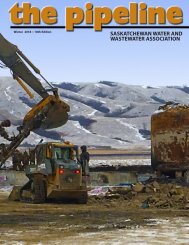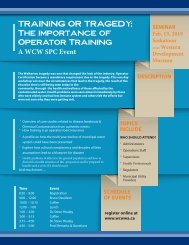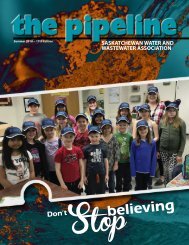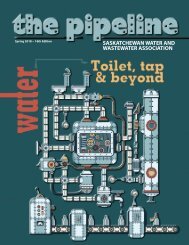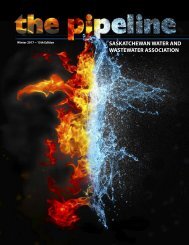2014 JUNE PIpeline
You also want an ePaper? Increase the reach of your titles
YUMPU automatically turns print PDFs into web optimized ePapers that Google loves.
solving<br />
theJust<br />
To those of us in the water and wastewater<br />
industry, the issue of non-dispersibles is not a new<br />
one. Ever since the invention of the modern toilet,<br />
users have developed a “flush and forget” attitude<br />
while those responsible for ensuring these systems<br />
function properly struggle with all manner of<br />
objects that inhibit efficient operation.<br />
Unfortunately, as our culture develops its sense of<br />
convenience and consumerism, the trend in<br />
marketing of “flushable products” is increasing. In<br />
order to help water and wastewater professionals<br />
deal with this issue, the Water Environment<br />
Federation has created a task force to address the<br />
non-dispersible problem. Through partnerships<br />
with like-minded organizations such as NACWA<br />
(National Association of Clean Water Agencies),<br />
WEF is developing tools that can be used by our<br />
industry to help educate the public about this<br />
problem. The article below is part of a regular<br />
publication informing our industry of the progress<br />
of this initiative. This and many other materials are<br />
available on the Water Environment Federation<br />
website, WWW.WEF.ORG.<br />
SOLVING THE NONDISPERSIBLE PROBLEM<br />
Water resource recovery facility (WRRF) personnel<br />
continually must deal with items in the wastewater<br />
stream that simply don’t belong there. Called<br />
nondispersibles, these materials take many shapes,<br />
but as the number and variety of packages of wet<br />
wipes accumulate on store shelves, they also are<br />
accumulating in collection systems. The Water<br />
Environment Federation (WEF; Alexandria, Va.), its<br />
members, and others have been working to solve<br />
the problem.<br />
During the WEFTEC® 2013 Technical Session 610,<br />
“Wipe Out: Reducing the Burden of Wipes in the<br />
Pipes,” speakers and panelists representing the<br />
Water Environment Federation (WEF; Alexandria,<br />
Va.), the Association of the Nonwoven Fabrics<br />
Industry (INDA; Cary, N.C.), the National Association<br />
of Clean Water Agencies (NACWA; Washington,<br />
D.C.), as well as manufacturers of disposable wipes<br />
and WRRF equipment provided a comprehensive<br />
view of the sources of contention that surround<br />
the topic.<br />
flush<br />
It<br />
problem<br />
“Ever since the<br />
invention of the<br />
modern toilet, users<br />
have developed a<br />
“flush and forget”<br />
attitude while those<br />
responsible for<br />
ensuring these<br />
systems function<br />
properly struggle with<br />
all manner of objects<br />
that inhibit efficient<br />
operation.”<br />
The issue recently has garnered<br />
much attention from the press<br />
and public. However, according to<br />
session moderator Robert Villée,<br />
disagreement remains on many<br />
topics, such as the definition for<br />
dispersibility, culprits for clogs, the<br />
timeline for implementing<br />
solutions, tests to verify product<br />
flushability, and proper labeling.<br />
“It’s a difficult issue, and there are a<br />
lot of nuisances,” said Villée, who is<br />
executive director of the Plainfield<br />
Area Regional Sewerage<br />
Authority (Middlesex, N.J.). Fixing<br />
the nondispersibles problem “will<br />
require a coordinated national<br />
effort” in which WEF works with<br />
other organizations in both the<br />
water and wastewater arenas, said speaker Aubrey Strause, owner<br />
of Verdant Water PLLC (Scarborough, Maine). While the challenges<br />
seem daunting, WEF members and WEF Member Associations<br />
(MAs) have started working on the problem and have been gaining<br />
momentum.<br />
WEF, NACWA, and the American Public Works Association (APWA;<br />
Washington, D.C) have approached the issue together. The three<br />
organizations are working to<br />
• build consensus on flushable standards,<br />
• educate the public about the problem, and<br />
• compile information on regional efforts in North America to<br />
solve the problem,<br />
Strause said.“The next step will be for these national groups to lead<br />
the development of a definition of flushable.”<br />
The WEF Collection Systems Committee (CSC) Flushables Task<br />
Group has been working to solve the problem since 2010; and at<br />
WEFTEC® 2012, the WEF House of Delegates Nondispersibles<br />
Workgroup formed. “HOD is tasked with supporting the CSC by<br />
getting the MAs involved and supporting efforts to bring pressure on<br />
the nonwoven fabric industry to change business as usual,” said Hiram<br />
Tanner, DC Water (Washington) manager and WEF House of<br />
Delegates (HOD) Nondispersible Workgroup member. Tanner<br />
Continued on page 24<br />
the pipeline | June <strong>2014</strong> 13


